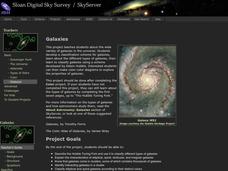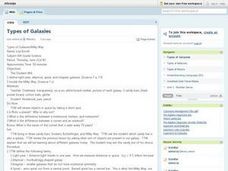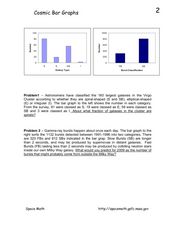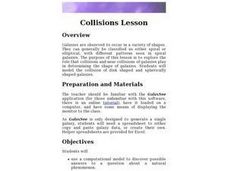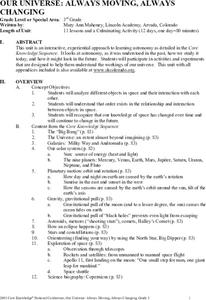American Museum of Natural History
The Milky Way Galaxy
Just how big is the galaxy? Learners read information about the size of the Milky Way galaxy to better comprehend its size. Pupils develop an understanding of the number of stars in the galaxy by finding just how big a billion is and...
Glynn County School System
Other Galaxies
The Milky Way belongs to a cluster of galaxies called the local group and it could be considered our neighborhood! Use the PowerPoint to present information on the different galaxy types, both local and farther away. Scholars learn how...
Star Date
Build Your Own Galaxy
Don't just look at pictures of the Milky Way galaxy, build it with this hands-on activity in which scientists recreate the galaxy we live in.
Curated OER
Galaxy Flashcards
On two pages you will find the pictures of 19 different galaxies and a Hubble "Tuning Ford" diagram. Print these out on cardstock and let primary space scientists use them to identify the three different types: spiral, elliptical, and...
Curated OER
Galaxies
The first thing to note is that this lesson was written for use in a parochial school. Even if you are in a non-religious setting, however, the website exploration of galaxies and the accompanying worksheet make for an engaging...
Curated OER
Galaxies
Tenth graders explore the structure and content of galaxies. Through discussion, lab, and hands-on activities, they discover the general structure of the three types of galaxies as well as the effect they have on the structure and...
Curated OER
Galaxies to Scale
In this scales and galaxies worksheet, students solve 7 problems including finding the size of galaxies in comparison to other galaxies and drawing scale models of the given galaxies to show their relative sizes and shapes.
Curated OER
Rotation Velocity of a Galaxy
In this orbit of stars in galaxies worksheet, students are given an equation that models the orbital speeds of stars as they relate to their distance from the nucleus of a galaxy. Students solve 5 problems using this equation and...
Curated OER
Exploring a Galaxy
In this galaxy worksheet, students use the Internet or other resources to answer 13 questions about the galaxy NGC-1232. They are given a photograph of the galaxy to help determine the width and diameter of certain regions of the galaxy.
Curated OER
Galaxies
Students use the provided website to classify galaxies after exploring information about elliptical, spiral, lenticular, and irregular galaxies and using the Hubble Tuning Fork.
Curated OER
A Galaxy Up Close
In this Sombrero Galaxy worksheet, students observe infrared images taken by the Spitzer Infrared Telescope and the Hubble Space Telescope. They answer 9 questions about the details of the images such as the radius of the stellar...
Curated OER
Types of Galaxies
Eighth graders take a quiz to review the different objects in space. As a class, they define terms related to galaxies. In groups, they make a model of the Milky Way galaxy using materials provided to them by their teacher. To end the...
Curated OER
Hunting for galaxies in the Hubble Deep Field
Learners examine Hubble Deep Field images. In this galaxy classification lesson, students research galaxy classification. Learners view and classify Hubble Deep field images of galaxies.
International Technology Education Association
Telescope as Time Machine
This resource provides an explanation of NASA's GALEX mission and how the space-based telescope can view distant galaxies as they were billions of years ago. The resource also discusses the other aspects of galaxies that GALEX is able to...
Curated OER
Cosmic Bar Graphs
In this cosmic bar graph worksheet, learners solve 2 problems using given bar graphs that plot the number of galaxies vs. the galaxy type and the number of gamma-ray bursts vs. the burst classification. Students find the fraction of...
Curated OER
The Milky Way and Beyond
Students consider the scale of the Milky Way Galaxy. In this Milky Way lesson plan, students hypothesize the length of time necessary to cross the Milky Way.
Curated OER
Virial Theorem Lesson
Ninth graders describe how equilibrium can occur as the balance of two effects. They model the stability of elliptical galaxies based on how fast stars within the galaxy are moving.
Curated OER
Collisions Lesson
Tenth graders explore the role that collisions and near collisions of galaxies play in determining the shape of galaxies. They model the collision of disk shaped and spherically shaped galaxies.
Glynn County School System
Cosmology
The past, the present, and the future ... there's so much to discover about the galaxy. Scholars learn about the creation of the universe, its current structure, and how it is changing. The PowerPoint presentation begins with a...
Curated OER
Our Home in the Milky Way
Young scholars gain appreciation of the vastness of our galaxy by viewing an applet about the Milky Way. Students hypothesize about how long it would take to get from Earth to Pluto.
Curated OER
Our Universe: Always Moving, Always Changing
Students explore the main concepts of astronomy through the eleven lessons of this unit. The past, present, and future methods of studying the science are examined in this unit.
Curated OER
Astronomy 30-3 Word Search
For this science worksheet, high schoolers locate and identify various vocabulary terms related to space science. There are 13 words/phrases located in the puzzle.
Curated OER
A Galactic Fact Sheet
In this galactic fact worksheet, learners read through important facts about galaxies, their shapes, and distances from the Sun.
Curated OER
Calculating Arc Lengths of Simple Functions-I
In this calculating arc lengths worksheet, students are given 4 simple functions and they use the Pythagorean Theorem and the basic techniques of calculus to find the arc-length formula in order to find the arc-length.











